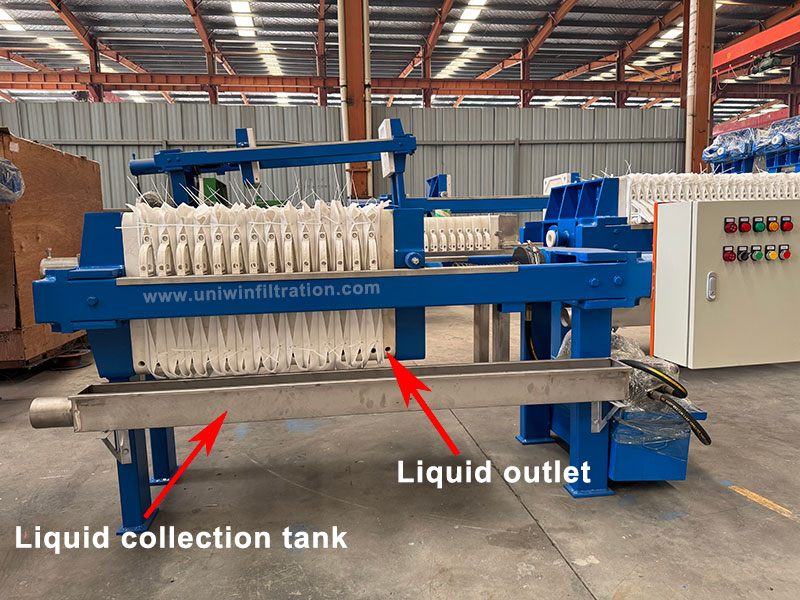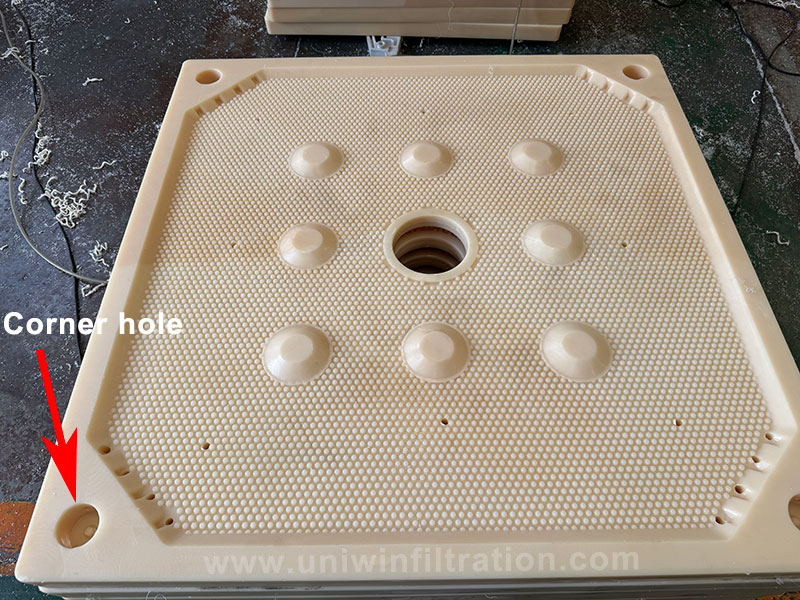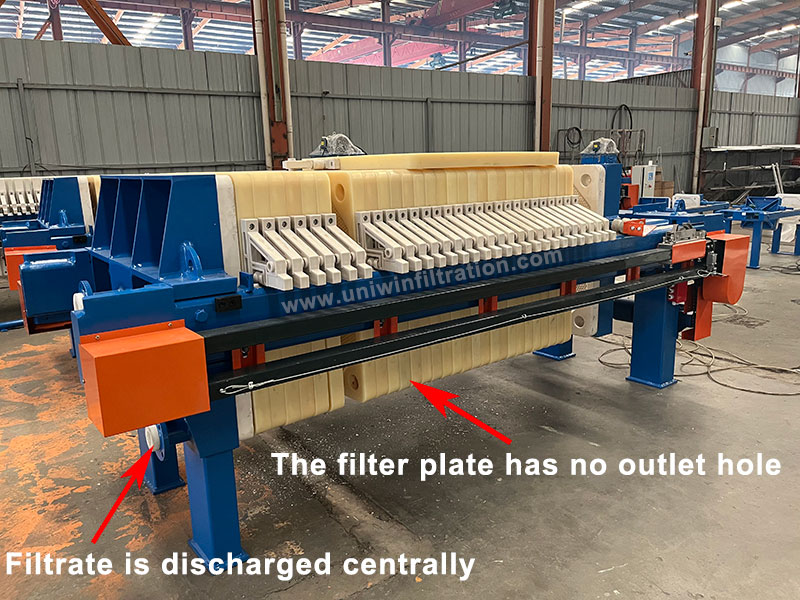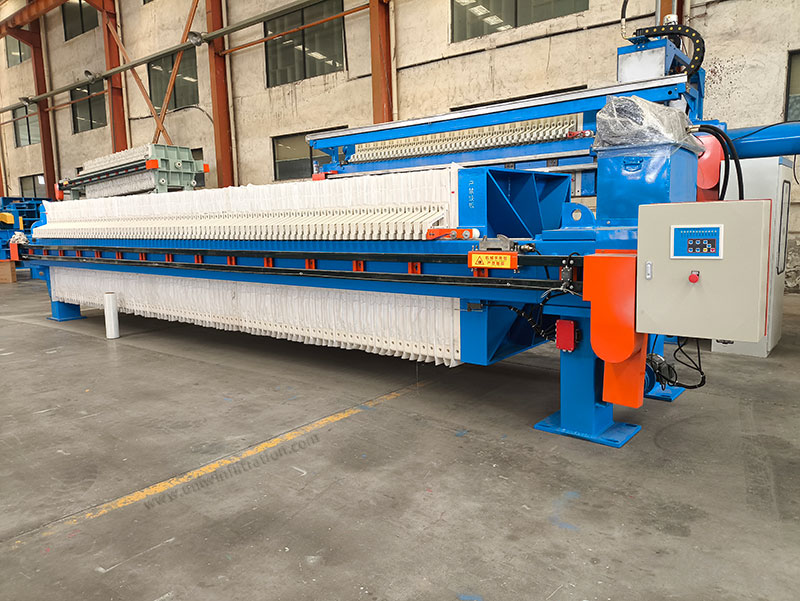The Difference Between an Open-Flow Filter Press and a Hidden-Flow Filter Press
In filter press applications, open-flow and hidden-flow filter presses are two common methods of liquid discharge. While they share the same principle, both achieving solid-liquid separation through filter cloth, they differ significantly in their discharge methods and structural characteristics. Understanding the differences between the two can help companies select the appropriate filter press type based on their operating conditions.
What is an Open-Flow Filter Press?
An open-flow filter press is a common type of solid-liquid separation equipment. Its characteristic is that after passing through the filter cloth, the filtrate is discharged directly from the outlet below the filter plate, allowing for a visually visible flow.
Due to its relatively simple structure and low manufacturing and maintenance costs, open-flow filter presses are commonly used in industries such as food, sugar production, and wastewater treatment. They are particularly suitable for processing general, non-toxic, and harmless materials. Operators can assess filtration effectiveness by observing the clarity of the filtrate, making it intuitive and convenient to use.

What is a Hidden-Flow Filter Press?
Unlike open-flow filter presses, hidden-flow filter presses do not discharge the filtrate directly. Instead, the filtrate is channeled through hidden channels within the filter plates and funneled into a drain pipe for centralized discharge in a closed environment. This effectively prevents filtrate leakage or volatilization, making it safer and more environmentally friendly.
Hidden-flow filter presses are widely used in the chemical and pharmaceutical industries, particularly for treating toxic, hazardous, or recyclable filtrates.
Open-Flow Filter Press VS Hidden-Flow Filter Press
Model Differences
The letter “M” in the filter press model number represents an open-flow filter press. This type of filter press is commonly used in applications with moderate filtrate requirements, such as food, ceramics, and environmental wastewater treatment.
The letter “A” represents a hidden-flow filter press, widely used in chemical, pharmaceutical, metallurgical, and environmental protection industries requiring closed-loop operation or filtrate recovery.
Differences in Filter Plate Structure
In an open-flow filter press, each filter plate has a drain valve below it. The filtrate flows directly from the filter chamber through the filter cloth into the collection tank. The internal structure of the filter plate is relatively simple, lacking additional internal channels. This open structure facilitates observation, but also offers weaker sealing.
In a hidden-flow filter press, the filter plates have corner holes perforated to form a hidden channel. After passing through the filter cloth, the filtrate enters the channel within the plate and then flows into the collection pipe for centralized discharge. This filter plate offers enhanced sealing, but also a more complex structure, requiring higher machining precision, and resulting in higher costs than open-flow plates.

Different Filter Cloth Structures
Open-flow filter presses do not require holes underneath the filter cloth, allowing the filtrate to drain directly. This results in a relatively simple structure and ease of processing. Assembly and disassembly are also relatively easy, making filter cloth replacement and cleaning more convenient.
Hidden-flow filter presses require precise alignment of the filter cloth with the corner holes on the filter plates, so perforations are necessary. The precise alignment of the perforations with the filter plates can lead to leakage or blockage. The assembly process is more complex, requiring a close fit to the filter plates to ensure a good seal.
Visibility and Operability
Open-flow: Operators can visually observe the clarity and flow rate of the filtrate, making it easier to determine if the filter cloth is damaged or if filtration is complete.
Hidden-flow: The effluent flows through the pipeline, making it difficult to directly observe and requiring auxiliary monitoring using a pressure gauge, flow meter, or sight glass.
Environment and Safety
Open-flow: The filtrate is exposed to the air, posing a safety hazard if handling hazardous, corrosive, or volatile materials.
Hidden-flow: The fully enclosed drainage process effectively prevents leakage and secondary contamination, making it particularly suitable for industries with stringent environmental requirements or where toxic or hazardous materials are involved.

Conclusion
Open-flow filter presses offer a simple, economical, and practical structure, making them suitable for handling generally harmless materials. Underflow filter presses, on the other hand, offer enhanced sealing and safety, making them suitable for applications involving toxic or hazardous materials or where filtrate recovery is required. When selecting a filter press, users should consider the material characteristics, process requirements, and budget to maximize its effectiveness.

